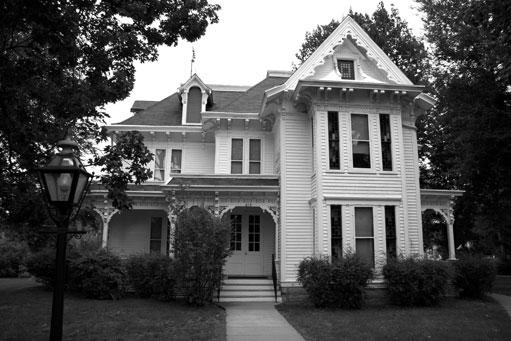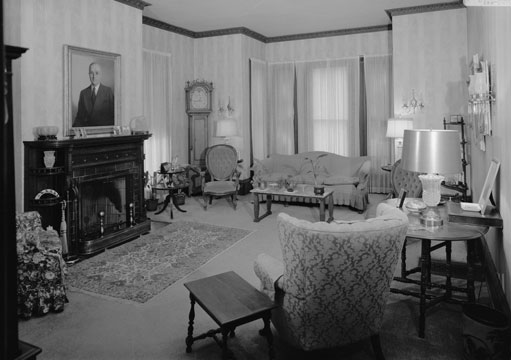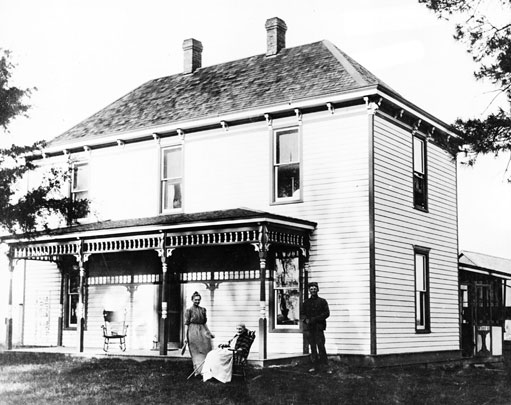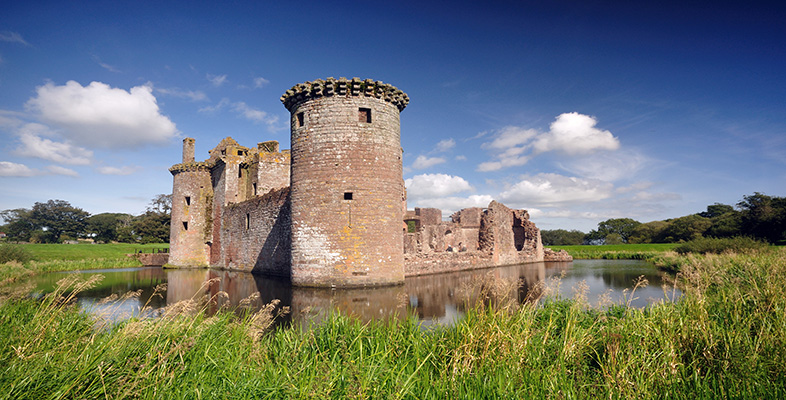4.1 Case study: Harry S. Truman National Historic Site, Missouri, USA
Harry S. Truman National Historic Site was gazetted (listed on the register of historic properties) on 23 May 1983 and opened to the public as a house museum on 15 May 1984 after Mrs Bess Truman (nee Wallace) donated the home to the US nation in her will. Bess Truman’s grandfather, George Porterfield Gates, built the fourteen-room, two-and-a-half storey ‘Queen Anne’ style house over the period 1867–95. It was the house in which the thirty-third US president Harry S. Truman lived during the period from his marriage to Bess Wallace on 28 June 1919 until his death on 26 December 1972. The historic site originally included just the ‘Truman Home’, however a series of other properties known as the Truman Farm, the Noland Home and the two Wallace Homes associated with the life of Truman were added to the site in the years that followed (see Figures 6–8).
The heritage values of this site are expressed by the US Department of the Interior National Park Service, the owners and managers of the site, in this way:
The Harry S Truman Historic Site ... contains tangible evidence of his life at home before, during, and after his presidency – places where forces molded and nurtured him.
The significance of Harry S Truman National Historic Site is derived from the time Harry Truman served as the thirty-third president of the United States, from 1945–1953. Yet the park includes physical evidence of a period lasting from 1867 through 1982. This span of time represents nearly the entire context of Harry Truman’s life, and encompasses all major park structures: Truman home, Noland home, Wallace homes and Truman farmhouse ... Most of his ideals concerning religion, social responsibility, financial stability and politics were derived from the people who lived here, as well as from his own experiences in these surroundings. Therefore, the park’s story can be extended backwards to the 1867 date, so long as any interpretation of these times has direct bearing on, and gives the visitor insight into, Harry Truman as president of the United States.

This place might be understood as a class of heritage place known as a ‘house museum’– a site maintained ‘as it was’ to give the public an insight into the life of a person or persons perceived to have been historically important. And, indeed, the statement of significance reproduced in part above certainly makes it clear that the significance of the property lies entirely in its ability to ‘give the visitor insight into Harry Truman as president of the United States’. The statement of significance gives the impression that the significance of the site is embodied within the physical material of the place and its contents: it contains ‘tangible evidence’ of the president and his life, and this material evidence has the ability to provide an insight into his ideas and the events of his presidency. This focus on the tangible and material, along with the rather pleasing setting of the home and its contents, seems consistent with Smith’s contention that the dominant western discourse of heritage is focused on material things rather than intangible practices.


While Truman himself did not belong to the upper classes, he can be seen as belonging to the ‘elite’ classes through his very powerful role as the president of the USA. As you will see from the photographs in Figures 6 and 7, the Truman Home is a rather humble dwelling for a president. Nonetheless, the Truman Home does demonstrate the features that Smith outlines, as even though the structure itself is reasonably humble, it gains its significance through its association with power and celebrity. It derives its status as a heritage site through its association with the ‘biggest and best’–important historical figures and great events. The home and its contents are presented in a manner that is both aesthetically pleasing and familiar to visitors as a ‘house museum’.
Another way in which the Truman Home conforms to Smith’s model is through the notion that there is some inherent virtue to this place that shaped Truman’s character and that can now be ‘read’ by the visitor. The association of the home with a ‘great historical figure’ is consistent with the concept of the AHD. But another key point which emerges from a close reading of the text is that the word ‘associated’ signifies ‘intangible’ heritage. It would be impossible to read this building as Truman’s home without the interpretive texts that tell us about the connection between Truman and the house. So there is a rather subtle interplay between the tangible and intangible aspects of heritage that are displayed in the text. The AHD balances the idea of the inherent significance of the fabric of the building against association, in this case, with Truman as president and what his relatively modest origins mean for current notions of US democracy.
The US Department of the Interior National Park Service General Management Plan (1999) specifies a series of further studies to be carried out to assist with the understanding and management of the Harry S. Truman Historic Site. These include an archaeological overview and assessment, cultural landscape reports, historic resources studies, long-term interpretive plan, and wildlife and vegetation surveys. These reports would be prepared, in this order, by an archaeologist, a cultural geographer or landscape architect, a historian, an interpretation specialist, and a zoologist and botanist. In specifying the form of planning documents required, the management plan establishes the expertise of particular professionals in assessing and documenting the heritage significance of the site. In this way, the general management plan excludes the views of the general public. It gives preference to the work of particular academic disciplines over members of the public or other (non-heritage) specialists who might form an opinion of the significance of the site; and this is despite the fact that the site is being conserved for the general public who ‘need to know as much about their leaders as possible; the type of people we elect to the presidency tells us a great deal about ourselves’ (1999, p. 7). Again, it is possible to see here the exclusion of the general public and the emphasis on heritage as the realm of professionals that Smith suggests are features of the AHD.
These ideas about heritage at the Truman Home do not exist in isolation, but flow down from various other documents which circulate particular ideas about heritage that make up what Smith refers to as the AHD. The National Historic Preservation Act 1966, as amended (NHPA), is the key piece of Federal legislation influencing the way in which heritage is managed and listed in the USA. Although the property was actually listed under the Historic Sites Act 1935, the NHPA is the legislative tool that governs the National Register of Historic Places on which the building sits alongside over 76,000 other heritage places or objects.
The NHPA defines the register as ‘composed of districts, sites, buildings, structures, and objects significant in US history, architecture, archaeology, engineering, and culture’ (Section 101 (a) (1) (A)). This definition immediately defines heritage as material, and the value of heritage as inherent in a ‘district, site, building, structure’ or ‘object’. In this sense, the Act can be seen as fulfilling the first of Smith’s characteristics of the AHD, that heritage is seen as contained within material things. The first section of the NHPA, which sets out its purpose, does more to realise many of the official ideas about heritage that Smith describes as comprising the AHD:
- (b)The Congress finds and declares that –
- the spirit and direction of the Nation are founded upon and reflected in its historic heritage;
- the historical and cultural foundations of the Nation should be preserved as a living part of our community life and development in order to give a sense of orientation to the American people;
- historic properties significant to the Nation’s heritage are being lost or substantially altered, often inadvertently, with increasing frequency;
he preservation of this irreplaceable heritage is in the public interest so that its vital legacy of cultural, educational, aesthetic, inspirational, economic, and energy benefits will be maintained and enriched for future generations of Americans ...
The NHPA declares the integral relationship between heritage and the nation, and the inherent ‘correctness’ of conserving heritage, which is seen to have a series of benefits to the well-being of the American people. It also introduces the idea that heritage is being lost ‘with increasing frequency’, which not only gives the act of conservation a sense of urgency in the light of this threat, but suggests a complete list of heritage (or a canon of heritage) that is being eroded by this loss. The Act specifies a range of heritage professionals as the experts on determining the values of heritage and the past through its explicit reference to ‘history, architecture, archaeology, (and) engineering’. It also places the ultimate responsibility for the categorisation and management of heritage in the hands of the Federal government, which further excludes the general public from decisions about determining the significance of heritage. The term ‘historic property’ itself seems to presuppose not only that heritage is physical but that it will be a bounded entity such as a building or place, rather than a practice or a series of characteristics contained within a broader landscape.
The criteria for entry on to the National Register are standards against which places nominated for inclusion on the register are assessed. These criteria are laid out in Part 60 of the National Register Federal Program Regulations.
National Register criteria for evaluation
The quality of significance in American history, architecture, archaeology, engineering, and culture is present in districts, sites, buildings, structures, and objects that possess integrity of location, design, setting, materials, workmanship, feeling, and association and
- a.that are associated with events that have made a significant contribution to the broad patterns of our history; or
- b.that are associated with the lives of persons significant in our past; or
- c.that embody the distinctive characteristics of a type, period, or method of construction, or that represent the work of a master, or that possess high artistic values, or that represent a significant and distinguishable entity whose components may lack individual distinction; or
- d.that have yielded, or may be likely to yield, information important in prehistory or history.
The emphasis in these criteria is on the archaeological, architectural or design values of a historic property. Clearly, a determination of what constitutes high archaeological value can only be carried out by an archaeologist. Similarly, architects and engineers would be involved in determining the values of the design and technical accomplishment in so far as these issues relate to historic properties. The use of complex threshold criteria also establishes the need for professionals to act as experts in undertaking a heritage assessment to determine whether or not a historic property meets the threshold.
The National Historic Preservation Act 1966 was passed two years after the Venice Charter. Although the USA had significant historic heritage legislation as early as 1906 with the Antiquities Act 1906, which protected historic or prehistoric remains on sites of scientific value on federal lands and made unauthorised destruction or removal of these remains illegal, the 1964 Venice Charter had a major influence on the way in which heritage was conceived and presented in the 1966 Act.
